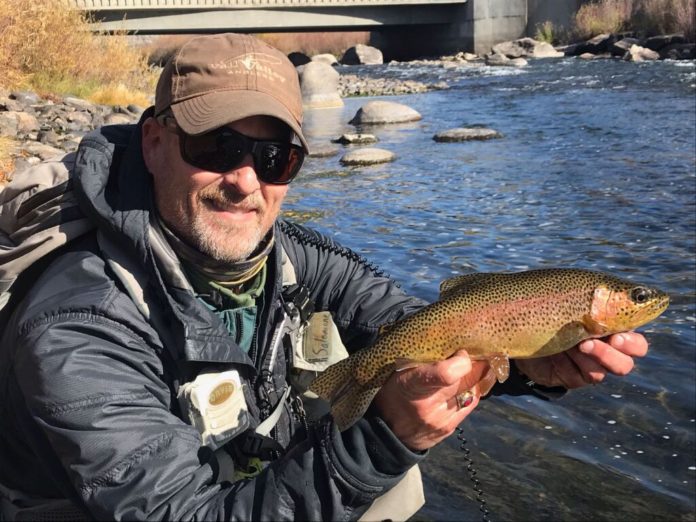Michael Salomone/Courtesy photo
For the most part, when I speak of flies I am referring to dry flies. It’s a habit. I think the dry fly is what most people associate with fly fishing. Fly anglers that approach a body of water; river, stream or pond, need to read the water to discern where to place their dry fly.
Midges are the most prevalent insect in any watershed. Available all year long at some stage, midges make up a significant portion of a trout’s diet. Individual midges are extremely difficult to fish. However, the Griffith’s Gnat represents a cluster of midges on the surface and is much easier for trout to target and for anglers to track.
Fish the Griffith’s Gnat in pockets along the bank. Large boulders attract midges that have newly hatched and are looking to mate. Trout will gravitate towards midges skating on the surface around boulders. Glass, calm waters are prime locations for midges to emerge and appear like small raindrops. Trout feeding on dries will show their nose and dorsal fin when feeding. Trout eating emergers will cause a disruption below the surface with their body submerged.
Michael Salomone/Courtesy photo
Mayflies are a favorite for feeding trout. Another prevalent insect, mayflies trigger surface feeding activity. Trout will follow a floating dry fly and inspect it before eating at their leisure. Mayflies float a considerable distance to allow for their wings to dry once they emerge.
The smooth water below shallow riffles is a prime location for a mayfly emergence. Trout target injured, crippled or stuck in the shuck mayflies as well as perfectly floating adults. Mayflies can appear minuscule in size all the way up to giant Green Drakes. Matching the size of your fly to the abundant naturals is the best approach for success.
Caddisflies are a favorite of fly anglers anywhere. The emerging caddis nymphs can swim swiftly and are very active insects. As adults, the moths bounce and dance on the surface immediately after they emerge. In the evening the female returns to the water to lay eggs. Broadcast layers, caddis will skitter across the surface spreading their eggs over a larger area. Trout will chase down a skittering caddis with intensity.
Because of the amount of activity caddis provide they are a dry fly that anglers can fish a little sloppy. High floating dries, half winged emergers, or a swinging dry fly that drowned during the drift, it really doesn’t matter. Trout eat caddis like my dad eats hamburger sliders, quickly and in one bite.
Stoneflies take years underwater to develop into maturity. During those years stoneflies can grow to impressive proportions. Salmonfly nymphs, some longer than your finger, will grow for three years before crawling out onto riverbanks, willows or rocks. Stoneflies must come completely out of the water to split from their exoskeleton. Plants and rocks will show the remnants from a stonefly emergence with empty husks clinging to river rocks. These husks will blow off with a stiff breeze, disguising the presence of the big bugs.
Michael Salomone/Courtesy photo
Anglers who find stonefly husks on the rocks will do well to tie on a Chubby Chernobyl or large Parachute Madame-X. Stonefly dries can be fished right down the middle of fast water. Casting a large silhouette fly onto the surface is easy for trout to track in fast water. Not wanting to miss a large bite of food, trout will smash stonefly dries. Water near large boulders is a prime area for trout looking for newly hatched, clumsy stoneflies.
Terrestrials are a group of insects that contain grasshoppers, ants and beetles. Fly anglers should cast terrestrials near overhanging vegetation. Tall, grass-lined riverbanks hold grasshoppers in late summer that inevitably end up in the river. Beetles are a sleeper fly most fly anglers don’t carry in their box or have one or two that may have never seen tippet before. That is a mistake. Trout seem to have a weak spot for high floating foam-bodied beetle flies. A dark beetle is very hard to track so fishing it in tandem with another dry fly is the best approach.
Dry flies bring the action to the surface. Knowing where to locate the best action with the fly you are fishing is key. Midges, mayflies and more, anglers need to read their water and know where to present their flies to find success.
Credit: Source link































